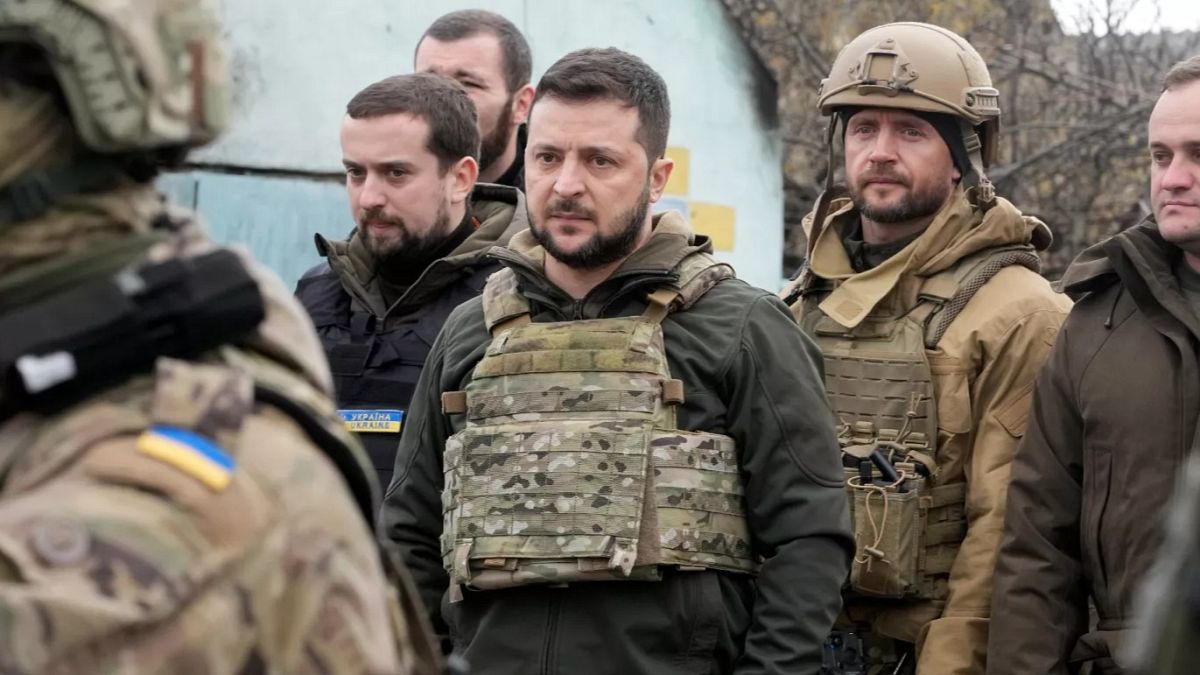
On 28 February 2022, four days into Moscow’s full-scale invasion of Ukraine, Russian forces had already occupied some towns on the Azov Sea coast, got close to the Zaporizhzhia nuclear power plant and the city of Mariupol, and were pushing towards Kyiv.
While millions of people across the country were sheltering from relentless missile and drone attacks, Ukrainian and Russian officials sat down for the first attempted negotiations to put an end to the war.
The delegations met on the border with Moscow’s key ally, Belarus, following the call between Ukrainian President Volodymyr Zelenskyy and his counterpart in Minsk, Alexander Lukashenko.
“We agreed that the Ukrainian delegation would meet with the Russian delegation without preconditions on the Ukrainian-Belarusian border, near the Pripyat River,” Zelenskyy said, as Ukraine called for an immediate ceasefire and withdrawal of Russian forces. Moscow didn’t reveal its aim in the negotiation.
Zelenskyy and Russian President Vladimir Putin did not participate in person.
Three rounds of talks were held in Belarus before they moved online on 14 March. By that time, Russian forces occupied the towns around Kyiv and started the alleged atrocities against the population of Hostomel, Irpin and Bucha.
When Moscow forces were pushed out of the Kyiv region, some of the starkest photographic and video evidence of Russian brutality in Ukraine emerged, throwing the early negotiations process into disarray.
Visiting Bucha in early April 2022, where bodies of civilians were found on the streets, tied and shot at close range by Russian troops before their withdrawal, Zelenskyy said, “That is real genocide, what you have seen here”.
Yet, as Kyiv embarked on war crimes investigations, having discovered the mass graves and Russian torture chambers for the first time, Zelenskyy said the peace talks would continue with Moscow “because Ukraine must have peace.”
“We are in Europe in the 21st century. We will continue efforts diplomatically and militarily,” he said. Yet, he admitted, “It’s very difficult to talk when you see what they’ve done here.”
Ukraine bans talks with Putin
A few months later, in September 2022, Putin announced the illegal seizure of four areas of Ukraine — the regions of Donetsk, Luhansk, Zaporizhzhia and Kherson — saying they were now Russian territory.
In response, Ukraine’s National Security and Defence Council imposed a ban on direct negotiations with Putin, which is still in place.
This January, Zelenskyy explained that the ban was introduced to stop separatism as “the Russians were trying to put pressure on Ukraine through many different corridors that Ukraine could not control”.
“Regarding whether we can talk (with Putin) or not (and) the decision of the National Security and Defence Council, why did I sign this decree? Because Putin had begun very quickly to establish a large number of different channels, in collaboration with separatists and officials from other states, in order to influence Ukraine, our independence, and me directly,” Zelenskyy explained.
“There were a lot of conversations going on and a lot of shadowy political corridors.”
“I quickly put a stop to it. I simply stopped separatism in our country by forbidding anyone – any political figures in Ukraine – from holding any negotiations with the Russian side, with Putin’s supporters, during the war,” he concluded.
The decision stated that the NSDC had decided to “state the impossibility of holding talks with Russian leader Vladimir Putin.”
It did not specify who was forbidden to hold talks.
Zelenskyy emphasised that he is the only one who can negotiate: “I am the president of Ukraine, I lead all the negotiations, and I have forbidden everyone else.” Putin, he said, “doesn’t like this because he has many channels.”
Russian authorities have repeatedly criticised this decision and demanded it be reconsidered.
Putin has used this argument to shift the blame onto Ukraine, claiming that Zelenskyy had no right to sign any peace agreements and referencing the Ukrainian president’s decree banning negotiations with the Russian leader in response to Moscow’s annexation of four Ukrainian regions.
What about ‘Minsk 3’?
However, Zelenskyy and Putin already met at the negotiating table. In December 2019 they met in Paris along with the leaders of France and Germany.
The so-called Normandy Format summit in the French capital was supposed to find a way to end what was then five years of fighting in eastern Ukraine and unfreeze the Minsk peace process, a set of talks that led to two separate agreements that were supposed to be legally binding.
In September 2014, Minsk Protocol (Minsk I), Russia committed to withdrawing illegal armed groups and military equipment from Ukraine.
The February 2015 Minsk II Agreement (Minsk II) promised the removal of all foreign armed forces and mercenaries under OSCE supervision and the disarmament of illegal groups.
Moscow didn’t fulfil these promises and instead embarked on its full-scale invasion of Ukraine two years after Zelenskyy and Putin met in Paris.
- Ukraine’s Zelenskyy says he is ready to hold direct talks with Putin
- If it depended on Ukraine, the war would be over tomorrow, says Zelenskyy’s top aide
Ukraine’s president has repeatedly reiterated that Kyiv needs strong security guarantees, not “situational agreements”.
He said, “I remember everything that happened as soon as I became president: there was the Minsk deal, there was a contact line, and people were dying along it every day”.
“We definitely won’t go for a Minsk-3.”





